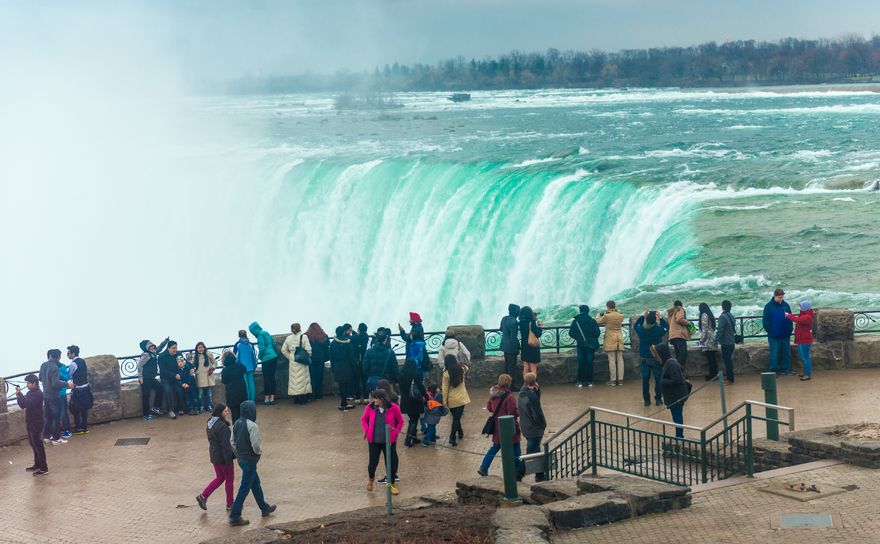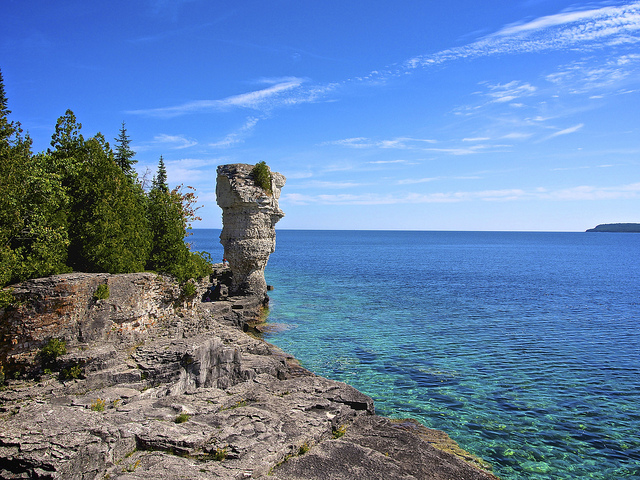Canada’s largest city is home to one of the most multicultural populations on the planet. The country’s cultural hub, Toronto is a major center for film and theater, with a wide range of museums, eclectic boutiques, and ethnic neighborhoods. The reclaimed waterfront along Lake Ontario has performance spaces and art galleries, along with a lakeside walking and cycling trail. This diversity has made Toronto one of North America’s most exciting cities for eating, shopping, and simply exploring.

On the Canadian side of Niagara Falls. Photo © yelo34/123rf.
Niagara Falls is a must-see attraction, and whether it’s your first visit or your 50th, feeling the spray and watching the cascading curtains crash into the river below is still a thrill. Yet Niagara is more than just the falls. Here in Ontario’s major wine-producing region, you can sip new vintages or sample local produce, while the well-preserved town of Niagara-on-the-Lake stages the Shaw Festival, one of North America’s premier summer theater festivals.
West of Toronto, sprawling suburbs give way to university towns with nascent arts scenes, wide- open farm country, and sandy beaches. Theater fans flock to the Stratford Festival, while in St. Jacobs, Mennonite communities preserve their traditional customs. You can tour Ontario’s newest wine district, visit Canada’s southernmost point, or explore the region’s dramatic history as the terminus of the Underground Railroad. Finally, you reach Lake Huron, where you can sit by the shore and watch the sun go down.
Water, water, everywhere—that’s what you’ll find in Eastern Ontario. Along Lake Ontario (home to the Prince Edward County wine and a hotbed of local food), in the Kawartha region around the city of Peterborough, among the Thousand Islands in the St. Lawrence River, and along the Rideau Canal between Kingston and Ottawa, lakes, rivers, and inland waterways mean beaches, boats, or just relaxing by the water. Yet this region has plenty for the history buff, too, from aboriginal culture to Canada’s early development.
Canada’s national capital combines history, culture, and outdoor activities. You can tour Parliament and numerous grand museums, then skate on the Rideau Canal (the world’s largest rink), or hike through sprawling Gatineau Park. For foodies, Ottawa has a branch of Le Cordon Bleu culinary school, a variety of food tours, and plenty of innovative restaurants. This bilingual city knows how to party, too, hosting the nation’s biggest Canada Day celebrations and dozens of festivals year-round.
Getting away to “the cottage” is a long-standing Ontario summer tradition, and even without a cottage of your own, you can escape to this lake district. The highlight is Algonquin Provincial Park, one of the province’s largest protected green spaces.
Cottage Country and Northeastern Ontario are prime canoe trip destinations, with an extensive network of lakes. For a more culturally focused trip, ride the Polar Bear Express train north to James Bay to experience the culture of one of Canada’s largest aboriginal groups.

A “flowerpot” rock formation in the Fathom Five Marine Park. Photo © Terry Ozon, licensed Creative Commons Attribution.
Spectacular scenery surrounds, where more than 30,000 islands dot the waters. Besides three national parks, several beautifully remote provincial parks, and sections of the Bruce Trail (Canada’s longest hiking route), you’ll find dramatic rock formations, Caribbean-blue water, and a network of lighthouses standing guard along the coast.
Ontario’s earliest European pioneers built a settlement near Georgian Bay, which is now a fascinating historic village. On Manitoulin Island, the Great Spirit Circle Trail is a leader in aboriginal tourism, offering numerous ways for visitors to experience First Nations culture.
Craving more eco-adventure? Head north to Lake Superior. Hiking trails crisscross rocky cliffs, while spectacular beaches line Lake Superior’s shores, and you can canoe, kayak, or sail to remote inlets and islands. Yet even if you’re just doing a driving tour along the lake, the views seem to get better around every turn.
Excerpted from the Second Edition of Moon Ontario.